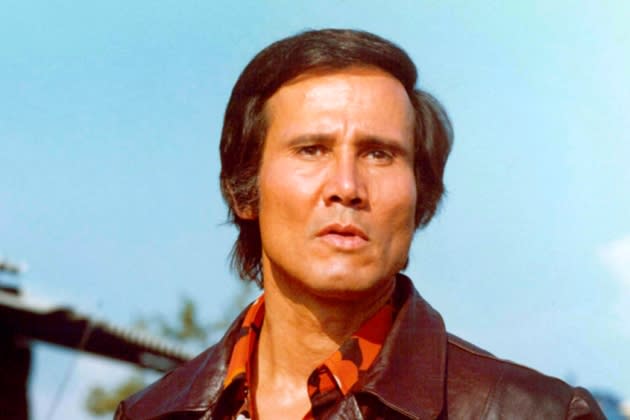
Henry Silva, an actor with a striking look who often played villains and had credits in hundreds of films including “Ocean’s Eleven” and “The Manchurian Candidate,” died of natural causes Wednesday at the Motion Picture Picture and Television Country House and Hospital in Woodland Hills, Calif., his son Scott confirmed. He was 95.
One of Silva’s most memorable roles came in John Frankenheimer’s classic thriller “The Manchurian Candidate” (1962), in which he played Chunjin, the Korean houseboy for Laurence Harvey’s Raymond Shaw — and an agent for the Communists — who engages in a thrilling, well-choreographed martial arts battle with Frank Sinatra’s Major Bennett Marco in Shaw’s New York apartment.
Silva appeared in a number of other movies with Sinatra, including the original, Rat Pack-populated “Ocean’s Eleven” (1960) with Dean Martin and Sammy Davis Jr., where he was one of the 11 thieves, and 1962 Western “Sergeants 3.”
His death was first reported by Dean Martin’s daughter Deana Martin, who wrote on Twitter, “Our hearts are broken at the loss of our dear friend Henry Silva, one of the nicest, kindest and most talented men I’ve had the pleasure of calling my friend. He was the last surviving star of the original Oceans 11 Movie. We love you Henry, you will be missed.”
Related video: Charlbi Dean, actress in ‘Black Lightning,” dies at 32
In later years, he appeared in Burt Reynolds vehicle “Sharky’s Machine” (1981), the Chuck Norris movie “Code of Silence” (1985), Steven Seagal movie “Above the Law” (1988), Warren Beatty’s “Dick Tracy” (1990) and Jim Jarmusch’s “Ghost Dog: The Way of the Samurai” (1999); Silva’s final screen appearance was a cameo in the “Ocean’s Eleven” remake in 2001.
A 1985 article by Knight-Ridder journalist Diane Haithman headlined “Henry Silva: The Actor You Love to Hate” began this way: “His face looms on screen. A face with sharp, high cheekbones and a blunt, tiny nose, a face that looks like it was cut out of steel and always is behind a gun. And eyes that see only the next victim. Cold eyes. The eyes of a psychopath. He doesn’t have to say a thing before you know you hate him. … Silva has made a lifelong career with that face (which, by the way, looks fatherly off-camera).”
Silva told Haithman that growing up in Spanish Harlem helped prepare him for the kinds of roles he would later play in movies. “ ‘I saw a lot of things in Harlem,’ he recalled in an accent rich with his New York origins. ‘It was the kind of place where if you lived on one block and you wanted to go a few blocks away, you had to take a couple of guys with you, or else you would get your ass kicked.’ “
Speaking of his career, the actor told the journalist, ” ‘I think the reason that I haven’t disappeared (as a popular “heavy”) is that the heavies I play are all leaders. I never play a wishy-washy anything. They’re interesting roles, because when you leave the theater, you remember these kinds of guys.’ ”
Silva first made an impression as the henchman to Richard Boone’s villain in Budd Boetticher’s 1957 Western “The Tall T,” starring Randolph Scott. He also appeared in Westerns including “The Law and Jake Wade” (he played Rennie, one of the Confederate ruffians led by Richard Widmark) and “The Bravados.”
In Fred Zinnemann’s “A Hatful of Rain” (1957), starring Don Murray and Eva Marie Saint, he played Mother, the supplier to Murray’s piteous morphine addict; Silva had created the role of Mother in 1955-56 in the original Broadway production of the play upon which the movie was based in which Ben Gazzara and Shelley Winters starred.
In Audrey Hepburn-Anthony Perkins vehicle “Greens Mansions” (1959), he played the evil son of the chief of a primitive tribe in the Venezuelan jungle; he also played a Native American in “Five Savage Men” (1970) and “Sergeants 3” (1962).
Silva starred as the title character in the 1963 crime drama “Johnny Cool,” in which his character assassinates Mafia bosses in order to gain control of an empire of his own. He also portrayed the title character, a Japanese secret agent earlier played by Peter Lorre, in 1965’s “The Return of Mr. Moto.”
According to an article on the website Cool Ass Cinema, Silva’s “talents as a leading man weren’t fully appreciated till he went to Europe, where Italian filmmakers put his wild eyed, intense face to good use after a fiery, scene-stealing performance in Carlo Lizzani’s exciting ‘The Hills Run Red’ (1966). “Silva really found his calling in European action thrillers as evidenced in Emilio Miraglia’s taut political thriller ‘Assassination’ (1967),” where he is reborn with a new identity, Chandler, trained as a political assassin and used to defeat an international crime syndicate. The actor starred the next year for Miraglia in “The Falling Man,” in which he played a cop framed for killing a police informer.
Silva got even busier in the 1970s, playing tough customers on both sides of the law in movies made in Europe. He had prominent roles, said Cool Ass Cinema, “in two of Fernando Di Leo’s most accomplished works — ‘Manhunt’ (1972) and ‘The Boss’ (1973) — the second and third of his Mafia trilogy that began with the superb genre classic ‘Milan Caliber 9’ (1972).” In ‘Manhunt,’ Silva and Woody Strode played American assassins out to silence a pimp who’s wrongfully blamed for the disappearance of a shipment of heroin; ‘The Boss’ saw one of Silva’s best performances, playing a hitman working for a Mafioso. “His role here,” said Cool Ass Cinema, “defined the signature Silva persona as an infallible, near indestructible presence bearing a cool and calculating demeanor.”
Other European credits during the ’70s include Andrea Bianchi’s brutal crime drama “Cry of a Prostitute,” Umberto Lenzi’s “Almost Human,” “Manhunt in the City” and “Free Hand for a Tough Cop,” “Weapons of Death” and finally 1979’s “Crimebusters.” “Manhunt in the City” showed a somewhat more vulnerable side of Silva as an ordinary man driven to seek vengeance when the law fails to punish the killers of his daughter.
In the 1980s he sometimes showed a humorous side as he appeared in roles parodying his earlier work, such as in “Cannonball Run 2.”
Silva was born in Brooklyn and grew up in Spanish Harlem. According to the book “Hispanics in Hollywood,” his parents were Italian and Puerto Rican. He quit school when he 13 and began to take drama classes while supporting himself as a dishwasher and eventually a waiter. Silva auditioned for the Actors Studio in 1955; he was one of five students accepted from a field of 2,500 applicants.
He’d made his television debut on “Armstrong Circle Theatre” in 1950 and his big-screen debut, uncredited, in Elia Kazan’s 1952 film “Viva Zapata!” starring Marlon Brando.
Silva was twice married in the 1950s; his third marriage, to Ruth Earl, lasted from 1966 until their divorce in 1987.
He is survived by two sons, Michael and Scott. Scott Silva asked that fans remember his father by commenting on his social accounts: Instagram: henrysilvaofficial; Twitter: @MrHenrySilva and Henry Silva official on Facebook.
Best of Variety
Sign up for Variety’s Newsletter. For the latest news, follow us on Facebook, Twitter, and Instagram.




